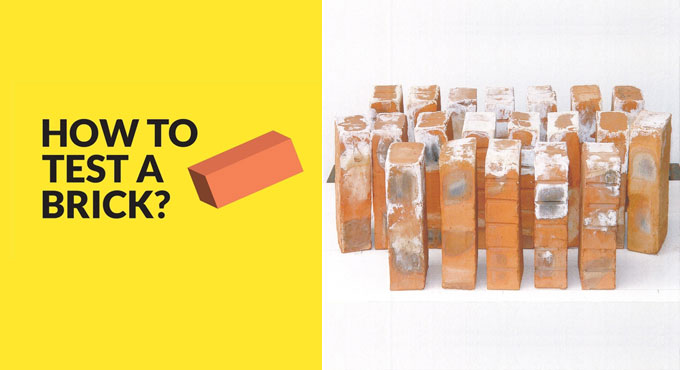To check the strength of bricks, the following 7 tests are conducted. Some tests are performed in laboratory and some are performed in the job site.

~~~~~~~~~~~~~~~~~~~~~~~~
Compressive strength test
The purpose of this test is to determine the compressive strength of brick. It is also known as crushing strength of brick. Normally, 5 samples of bricks are sent to laboratory for testing one by one. Under this test, a brick sample is provided on crushing machine and the pressure is enforced unless it ruptures. The ultimate pressure by which the brick is ruptured is noted. The samples of all five bricks are examined one by one and average result is considered as the compressive or crushing strength of brick.
Water Absorption Test
Under this test, the weight of the bricks is taken in dry condition and submerge them in fresh water for 24 hours. Once 24 hours is completed, the bricks are pulled out from water and wipe out with cloth. After that, the weight of the brick is taken in wet condition. The variation among weights is the water engrossed by brick. The percentage of water absorption is then measured. If brick engrosses less water, the quality will be superior. Standard quality brick should not engross in excess of 20% water of its own weight.
Efflorescence Test
If alkalis exist in bricks, they develop a grey or white layer on the surface of brick by absorbing moisture. The objective of this test is to determine the existence of alkalis in bricks. Under this test, a brick is submerged in fresh water for 24 hours and then it is pulled out from water and lets to dry in shade. If the whitish layer is not shown on surface, it ensures that alkalis are not present in brick. If the whitish layer is about 10% of brick surface, then the existence of alkalis is permissible. If that remains about 50% of surface, then it is mild. If the existence of alkalis is in excess of 50%, then the brick is significantly affected with alkalis.
Hardened Test
Under this test, a scratch is created on the surface of brick through a solid object. If that doesn’t make any mark on brick, then the quality of brick is superior.
Size, shape and color test
Under this test, arbitrarily chosen 20 bricks are staked as per length, width and height and then those are calculated to find out the differences in sizes according to standard. The bricks are thoroughly monitored to ensure its edges are sharp, straight and consistent in shape. A standard quality brick should contain bright and consistent color right through.
Soundness Test
Under this test, two bricks are taken by both hands and stricken with each other. If, clear metallic sound is produced and the bricks are not broken, then the quality of the bricks is superior.
Structure Test
Under this test, a brick is split or a split break is selected and thoroughly inspected. If there exist any flows, cracks or holes on that broken face, the quality of the brick is not up to the standard.
For this purpose, concrete pros hold up the rebar grids on special metal or plastic supports, known as "chairs." The bricks and other scrap material can also be employed for supports, but it can produce weak spots in the slab. Rebar grids are built up by placing the pieces of bar in a perpendicular pattern, with equal span.
The bars are secured jointly at each intersection through metal wire. The edges of the grid should be retained at same gaps from all sides of the slab, and the minimum coverage of concrete should be retained all through the slab.

No comments:
Post a Comment